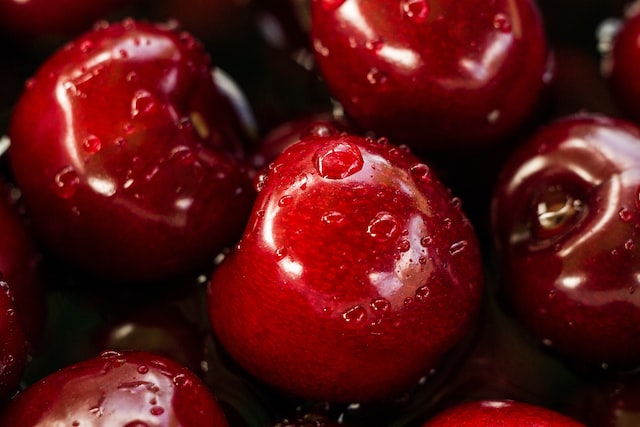Experience the Essence of Cherry
The Allure of Cherries: A Feast for the Senses
Cherries, with their vibrant colors and sweet, juicy taste, have captivated human senses for centuries. From perfumes and fragrances to therapeutic oils, cherries have found their way into various aspects of our lives, not just as a delicious treat but also as a symbol of indulgence and abundance. Let's delve into the multifaceted world of cherries, exploring their culinary delights, aromatic allure, therapeutic potential, medicinal uses, historical significance, and fun, crazy facts.
Culinary Delights: Cherries are a cherished fruit in the culinary world, used in an array of delectable dishes. From cherry pies and tarts to cherry preserves and sauces, their sweet and tangy flavor adds a burst of delight to desserts and savory dishes alike. Fresh cherries are enjoyed as a simple and refreshing snack, while dried cherries make for a wholesome addition to granolas and salads.
Aromatic Allure in Perfumes: The luscious scent of cherries has inspired perfumers to capture its essence in fragrances. Cherry notes are often used in sweet and fruity perfumes, creating a sense of youthful exuberance and playfulness. The scent of cherries can evoke images of sun-kissed orchards and lazy summer afternoons, making it a popular choice in many perfume compositions.
Therapeutic Potential: Cherries, especially sour cherries, are known for their potential health benefits. They are a rich source of antioxidants, particularly anthocyanins, which have been linked to reducing inflammation and oxidative stress in the body. Tart cherry juice is believed to aid in post-exercise recovery and support healthy sleep due to its melatonin content.
Medicinal Uses: Cherries have also been used in traditional medicinal systems for various purposes. In certain cultures, cherry bark has been utilized as a natural remedy for coughs and sore throats. Cherry extracts have been incorporated into herbal preparations for their potential anti-inflammatory and pain-relieving properties.
Historical Significance: Cherries have a long and storied history, with records of their cultivation dating back to ancient civilizations. Cherries are believed to have originated in Asia Minor and were later cultivated by the Greeks and Romans. Cherries were treasured for their delightful taste and became a favorite among European royalty during the Renaissance.
Cultural Symbolism and Fun Facts:
Cherries are more than just a fruit; they are a feast for the senses. From their culinary delights to their aromatic allure in perfumes, cherries have an enduring appeal that transcends cultures and time. As we enjoy the sweetness of cherries, let us also appreciate their potential therapeutic benefits and historical significance. Cherries are not just a treat for the taste buds; they are a reminder of the beauty and abundance of nature, delighting our senses and filling our lives with joy.
Cherries, with their vibrant colors and sweet, juicy taste, have captivated human senses for centuries. From perfumes and fragrances to therapeutic oils, cherries have found their way into various aspects of our lives, not just as a delicious treat but also as a symbol of indulgence and abundance. Let's delve into the multifaceted world of cherries, exploring their culinary delights, aromatic allure, therapeutic potential, medicinal uses, historical significance, and fun, crazy facts.
Culinary Delights: Cherries are a cherished fruit in the culinary world, used in an array of delectable dishes. From cherry pies and tarts to cherry preserves and sauces, their sweet and tangy flavor adds a burst of delight to desserts and savory dishes alike. Fresh cherries are enjoyed as a simple and refreshing snack, while dried cherries make for a wholesome addition to granolas and salads.
Aromatic Allure in Perfumes: The luscious scent of cherries has inspired perfumers to capture its essence in fragrances. Cherry notes are often used in sweet and fruity perfumes, creating a sense of youthful exuberance and playfulness. The scent of cherries can evoke images of sun-kissed orchards and lazy summer afternoons, making it a popular choice in many perfume compositions.
Therapeutic Potential: Cherries, especially sour cherries, are known for their potential health benefits. They are a rich source of antioxidants, particularly anthocyanins, which have been linked to reducing inflammation and oxidative stress in the body. Tart cherry juice is believed to aid in post-exercise recovery and support healthy sleep due to its melatonin content.
Medicinal Uses: Cherries have also been used in traditional medicinal systems for various purposes. In certain cultures, cherry bark has been utilized as a natural remedy for coughs and sore throats. Cherry extracts have been incorporated into herbal preparations for their potential anti-inflammatory and pain-relieving properties.
Historical Significance: Cherries have a long and storied history, with records of their cultivation dating back to ancient civilizations. Cherries are believed to have originated in Asia Minor and were later cultivated by the Greeks and Romans. Cherries were treasured for their delightful taste and became a favorite among European royalty during the Renaissance.
Cultural Symbolism and Fun Facts:
- In Japanese culture, cherry blossoms are highly revered and symbolize the fleeting nature of life and beauty.
- Washington, D.C., holds an annual National Cherry Blossom Festival to celebrate the gift of 3,000 cherry trees from Japan in 1912.
- The word "cherry" is sometimes used colloquially to describe something that is excellent or of high quality.
Cherries are more than just a fruit; they are a feast for the senses. From their culinary delights to their aromatic allure in perfumes, cherries have an enduring appeal that transcends cultures and time. As we enjoy the sweetness of cherries, let us also appreciate their potential therapeutic benefits and historical significance. Cherries are not just a treat for the taste buds; they are a reminder of the beauty and abundance of nature, delighting our senses and filling our lives with joy.
To experience augmented reality, please open the Facebook-app using QR code and point to the image below
Explore Our Cherry-Scented Perfume Collection
Cherries are a type of fruit that belongs to the Prunus genus and are part of the rose family. They come in two main varieties: sweet and sour. Sweet cherries are typically eaten fresh, while sour cherries are often used in cooking and baking. The cherry tree is known for its beautiful blossoms and is often grown for ornamental purposes. Cherries are also a popular ingredient in desserts and jams, and are also used in the production of cherry liqueurs such as cherry brandy and Kirsch. Additionally, cherries contain antioxidants, which can help to reduce inflammation and lower the risk of certain diseases.
Cherries are a member of the stone fruit family, which also includes apricots, plums, and peaches. Cherries come in two main varieties: sweet and sour. The cherry tree is known for its beautiful blossoms and is often grown for ornamental purposes. Cherries are also a popular ingredient in desserts and jams, and are also used in the production of cherry liqueurs such as cherry brandy and Kirsch. Additionally, cherries contain antioxidants, which can help to reduce inflammation and lower the risk of certain diseases.
Embrace the Freshness of Citrusy Cherry
Cherries have been used in cuisine for centuries, with references to cherry dishes dating back to ancient Rome. They have also been depicted in art throughout history, with cherries appearing in still lifes, portraits, and other types of artwork.
In pop culture, cherry is often used as a symbol of temptation and forbidden fruit. They are also associated with the idea of "cherry picking" which means choosing only the best or easiest options.
In the art, cherries are often used as a symbol of love, innocence, and beauty. They are also used to symbolize the fleeting nature of life, as cherry blossoms only bloom for a short time each year.
Cherry is also a popular flavor in various types of confectionery, ice cream, and soft drinks.
In some culture, cherry festival is also celebrated like the National Cherry Festival in Traverse City, Michigan, USA.
In pop culture, cherry is often used as a symbol of temptation and forbidden fruit. They are also associated with the idea of "cherry picking" which means choosing only the best or easiest options.
In the art, cherries are often used as a symbol of love, innocence, and beauty. They are also used to symbolize the fleeting nature of life, as cherry blossoms only bloom for a short time each year.
Cherry is also a popular flavor in various types of confectionery, ice cream, and soft drinks.
In some culture, cherry festival is also celebrated like the National Cherry Festival in Traverse City, Michigan, USA.
Cherry Fragrance: A Natural Aromatherapy Choice
There are several famous paintings that feature cherries as a prominent subject or symbol. Some examples include:
- "Still Life with Cherries" by Jan Davidsz de Heem (1660s) - This Baroque-style painting features a detailed still life of cherries in a glass bowl.
- "Still Life with Cherries and Strawberries" by Paul Cézanne (1890-1894) - This Post-Impressionist painting features a still life of cherries and strawberries arranged on a table.
- "Cherries" by Claude Monet (1880-1882) - This Impressionist painting features a close-up of a cherry tree in bloom, with the focus on the play of light on the cherry blossoms.
- "Cherries" by Pierre-Auguste Renoir (1888) - This Impressionist painting features a still life of cherries in a glass bowl, with a focus on the rich colors and textures of the fruit.
- "Cherries" by Henri Fantin-Latour (1864) - This still life painting features a bowl of cherries and a vase of flowers set against a dark background.
- "Cherries and Peaches" by William Michael Harnett (1880) - This American still life painting features a detailed depiction of a bowl of cherries and peaches set on a table.
- "A Basket of Cherries" by Adriaen Coorte (1697-1707) - This Dutch still life painting features a basket of cherries and other fruits.
Scentopia Singapore's Commitment to Quality
The scent of cherries is primarily composed of several chemical compounds, including benzaldehyde, benzyl alcohol, and benzyl acetate. These compounds are responsible for the sweet, fruity aroma of cherries. Benzaldehyde is responsible for the characteristic almond-like aroma of cherries, while benzyl alcohol provides a floral, sweet aroma. Benzyl acetate gives a fruity, sweet and floral aroma to cherry. Additionally, other compounds such as δ-decalactone, which has a fruity, creamy and peach-like aroma, and α-terpineol, which has a floral, fresh and pine-like aroma, are also present in the cherry scent profile. The cherry scent is also composed of other minor compounds such as esters, aldehydes, alcohols, ketones and terpenes. The concentration and ratio of these compounds vary depending on the variety of cherry and its ripeness.
The Art of Crafting Cherry-Scented Perfumes
There are many famous brands that produce cherry-scented perfumes. Some of the most popular ones include:
- Marc Jacobs – Daisy Dream Forever
- Yves Saint Laurent - Black Opium Nuit Blanche
- Dolce & Gabbana - The One
- Gucci - Bloom
- Prada - Candy
- Burberry - My Burberry Black
- Versace - Bright Crystal
- Lancome - La vie est belle
- Dior - J'adore
- Thierry Mugler - Angel
Join Scentopia, Sentosa's latest tourist attraction wonderful orchid scent crafting, fragrance tour, bridal shower or corporate team building which includes perfume making onsite and offsite, beach activities and more. We also serve primary school learning journey, secondary students and pupil on industrial excursions. Know more about our orchids perfume bar or therapeutic orchid scents and other wellness aromas. Conatct Perfume workshop or book a scent crafting session here.






